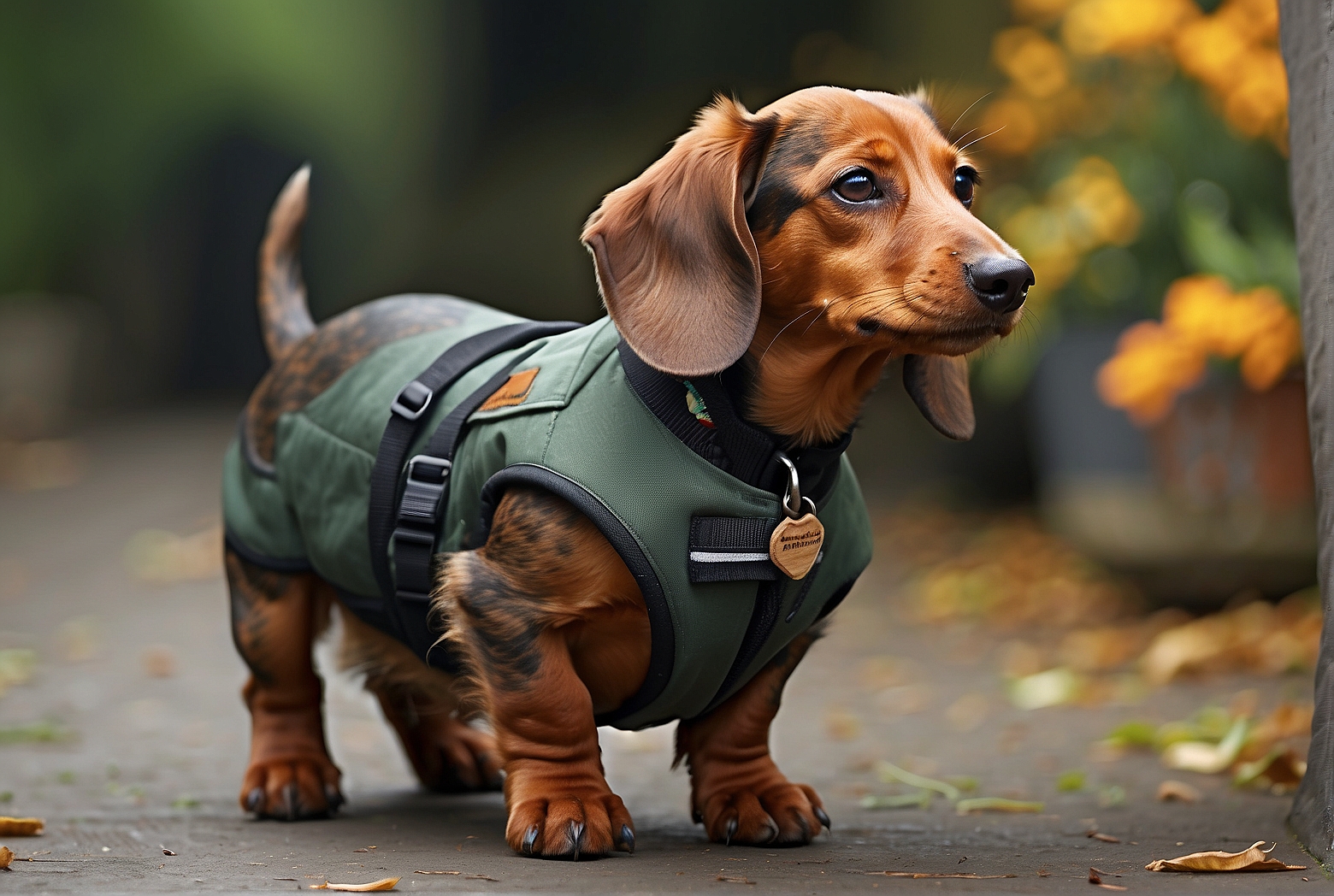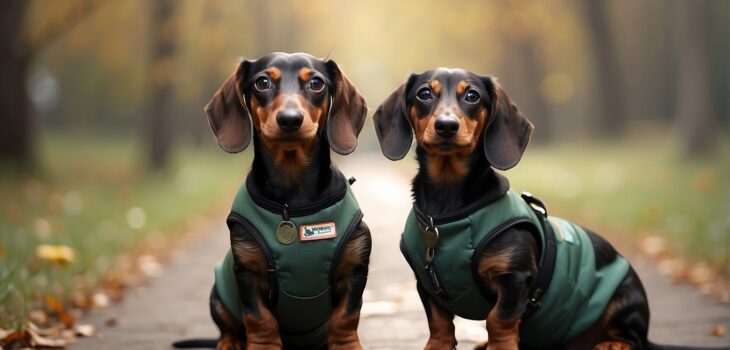Last Updated on April 1, 2024 by admin
If you’ve ever wondered if a Dachshund can become a service dog, you’re not alone. These small and affectionate dogs may not be the first breed that comes to mind when thinking of service animals, but their intelligence, loyalty, and adaptability make them surprisingly capable candidates. While their size may present some challenges, Dachshunds have shown that they can excel in various service roles, providing invaluable assistance to individuals with disabilities. In this article, we’ll explore the qualities that make Dachshunds potential service dogs and shed light on the important work they can undertake to enhance the lives of those in need.
Introduction
When it comes to service dogs, the first breeds that come to mind are often German Shepherds, Labrador Retrievers, or Golden Retrievers. But what about Dachshunds? These lovable wiener dogs may not fit the stereotypical image of a service dog, but they certainly have the potential to excel in this important role. In this comprehensive article, we will explore the qualities of service dogs, delve into the unique characteristics of Dachshunds, discuss the challenges they might face as service dogs, and provide considerations for potential handlers. So, can a Dachshund become a service dog? Let’s find out!
Understanding Service Dogs
Definition of a service dog
A service dog is not just a pet; it is a highly trained and skilled companion that assists individuals with disabilities. These dogs undergo extensive training to perform specific tasks that help mitigate the handler’s disability. The tasks can range from fetching objects and opening doors to providing stability and alerting to medical conditions.
Different types of service dogs
Service dogs can be categorized into various types based on the disabilities they are trained to assist with. Some common types include guide dogs for the visually impaired, hearing dogs for the deaf, mobility assistance dogs for those with physical disabilities, and medical alert dogs for individuals with conditions like diabetes or epilepsy.

Tasks performed by service dogs
The tasks performed by service dogs are as diverse as the disabilities they serve. These dogs can be trained to retrieve dropped items, open or close doors, provide balance and support while walking, alert their handlers to sounds or dangers, detect changes in blood sugar levels, and respond to specific medical conditions. The range of tasks depends on the handler’s needs and the dog’s capabilities.
Qualities of Service Dogs
Intelligence and trainability
One of the most important qualities of a successful service dog is intelligence. Service dogs are expected to learn complex commands and tasks, so they need to be quick learners. Dachshunds are known for their intelligence and eagerness to please, making them highly trainable candidates for service work.
Physical abilities and size
Service dogs must possess the physical abilities necessary to perform their tasks effectively. While Dachshunds may be small in size, they are known for their remarkable agility and speed. They have a low center of gravity, which makes them stable and well-balanced, despite their long bodies. Additionally, their relatively small size allows them to navigate tight spaces with ease, making them well-suited for certain service tasks.
Temperament and behavior
A calm and composed temperament is essential for a service dog, allowing them to remain focused and attentive to their handler’s needs. Dachshunds are generally good-natured, loyal, and eager to please, making them suitable candidates for service work. However, it is important to note that individual temperament can vary, so thorough temperament assessments should be conducted to ensure the dog’s suitability for the role.

Health and longevity
As service dogs are expected to work for extended periods, their health and longevity are crucial factors. Dachshunds are generally healthy dogs, but they are prone to certain conditions such as intervertebral disc disease and obesity. Regular veterinary care, proper nutrition, and a well-managed exercise routine can help mitigate these health concerns and ensure the dog’s longevity in service.
Dachshund Breed Overview
Brief history and origin
Dachshunds, also known as wiener dogs or sausage dogs, originated in Germany centuries ago. They were initially bred to hunt badgers and other small game, utilizing their elongated bodies and exceptional sense of smell. Over time, they became popular as family pets due to their affectionate nature and distinctive appearance.
Physical characteristics
Dachshunds have a distinct appearance characterized by their long bodies, short legs, and elongated snouts. They come in different coat types, including smooth, wirehaired, and longhaired, with various color and pattern variations. Despite their small size, Dachshunds possess a sturdy frame and muscular build.
Temperament and behavior
Dachshunds have a reputation for being brave, curious, and sometimes stubborn. They are known to be loyal and protective of their families. These dogs can sometimes exhibit a strong prey drive due to their hunting background. However, early socialization and positive reinforcement training can help shape their behavior and adaptability in different environments.
Common health concerns
Dachshunds are prone to certain health issues, primarily related to their long backs and short legs. Intervertebral disc disease, which can cause back problems and paralysis, is a significant concern for the breed. Obesity can also be a risk due to their appetites and decreased mobility. Regular exercise, a healthy diet, and weight management are crucial for maintaining their overall health and well-being.
Challenges for Dachshunds as Service Dogs
Size and physical limitations
One of the main challenges for Dachshunds as service dogs is their small size. While their compact stature can be advantageous in some situations, it may limit their ability to perform certain tasks that require larger dogs. However, with careful consideration and proper task selection, many Dachshunds can still contribute effectively as service dogs.
Potential back problems
Due to their elongated bodies, Dachshunds are more susceptible to back issues, including intervertebral disc disease. This condition can cause pain and mobility issues, potentially impairing their ability to perform service tasks. It is crucial for handlers to prioritize their Dachshund’s spinal health and take preventive measures to minimize the risk of back problems.
Energy levels and exercise needs
Dachshunds have moderate energy levels and require regular exercise to keep them mentally and physically stimulated. However, their exercise needs may be different compared to other breeds. Handlers should take into account their Dachshund’s potential physical limitations and tailor their exercise routines accordingly. Proper exercise and mental stimulation are vital for their overall well-being.
Training Considerations for Dachshunds
Importance of early socialization
Early socialization plays a crucial role in shaping a Dachshund’s behavior and adaptability. Exposing them to various environments, people, and animals from a young age can help prevent potential fear or aggression issues as they mature. Enrolling them in puppy socialization classes and providing positive experiences will set them up for success in their service dog journey.
Basic obedience training
A solid foundation of basic obedience training is essential for any service dog, including Dachshunds. Training commands like sit, stay, come, and heel are fundamental for their safety and the handler’s control. Positive reinforcement techniques, using treats or praise, work well with Dachshunds, as they respond best to rewards and gentle guidance.
Task-specific training
Each service dog is trained to perform specific tasks based on their handler’s needs. Dachshunds can excel in tasks that utilize their agility, such as retrieving small items, opening drawers, or alerting to sounds. It is important to break down tasks into manageable steps and use consistent training techniques to help Dachshunds understand and execute their tasks accurately.
Adapting training techniques for Dachshunds
While Dachshunds are intelligent and willing learners, their stubborn streak can present training challenges. Positive reinforcement methods, patience, and consistency are key when training Dachshunds. Breaking training sessions into shorter, more frequent intervals can help maintain their focus and prevent boredom. Adapting techniques and using rewards that motivate their individual preferences can also yield better results.
Successful Examples of Dachshund Service Dogs
Stories and case studies
There have been numerous success stories of Dachshunds serving as exceptional service dogs. From assisting individuals with mobility challenges to alerting to medical conditions, these small but mighty dogs have proved their capabilities and dedication to their handlers.
Types of tasks they perform
Dachshunds have been trained to perform a wide range of tasks. They can retrieve items, provide balance and support, open and close doors, alert to sounds or dangers, and perform various medical alert tasks. Their size and agility make them particularly well-suited for tasks that require accessing tight spaces or navigating crowded environments.
Challenges they overcome
Dachshunds, despite their physical limitations, can overcome challenges and excel as service dogs. Through proper training, ongoing monitoring of their spinal health, and careful task selection, Dachshunds have proven that their size does not hinder their ability to provide valuable assistance and support to their disabled handlers.
Legal Requirements for Service Dogs
Americans with Disabilities Act (ADA)
In the United States, the Americans with Disabilities Act (ADA) defines the rights and responsibilities of service dog handlers. According to the ADA, service dogs are allowed to accompany their handlers in public places, including restaurants, hotels, and stores. Businesses are prohibited from discriminating against individuals with disabilities and their service dogs, as long as the dog is trained to perform specific tasks to assist the handler.
Emotional Support Animals (ESA)
Emotional Support Animals (ESAs) are not considered service dogs under the ADA. While they provide comfort and support to individuals with emotional or psychological disorders, they are not trained to perform specific tasks. ESAs do have certain legal protections under the Fair Housing Act and the Air Carrier Access Act, which allow them to live with their owners in housing and travel in airplanes.
Other legal considerations
It is important to research and understand the legal requirements and protections specific to service dogs in your country or state. Different jurisdictions may have varying laws and regulations that affect the rights and access of service dog handlers. Familiarizing yourself with the applicable laws will ensure that both you and your Dachshund service dog are well-informed and protected.
Considerations for Potential Handlers
Specific needs and disabilities
When considering a Dachshund as a service dog, potential handlers must carefully evaluate their specific needs and disabilities. Certain disabilities may require tasks that are better suited for larger breeds or different types of service dogs. Consulting with healthcare professionals, service dog trainers, and experienced handlers can provide valuable insights and guidance in determining the suitability of a Dachshund as a service dog for individual circumstances.
Lifestyle and daily routines
The lifestyle and daily routines of potential handlers should also be taken into account. Dachshunds, like all service dogs, require regular exercise, mental stimulation, and dedicated care. Handlers should ensure that they can meet these requirements and provide a suitable environment for their Dachshund service dog to thrive. Lifestyle adjustments and commitments are necessary to fulfill the role of a service dog handler effectively.
Financial implications
Owning and caring for a service dog, including a Dachshund, comes with financial commitments. These include veterinary care, grooming, proper nutrition, specialized equipment, training classes, and ongoing maintenance expenses. Potential handlers should consider the financial implications associated with owning a Dachshund service dog and plan accordingly.
Alternative options if a Dachshund is not suitable
If a Dachshund is not deemed suitable for a particular individual’s needs, there are alternative options to explore. Other breeds or types of service dogs may better meet the specific requirements. Alternatively, organizations that specialize in providing trained service dogs can be contacted to find a suitable match. It is crucial to prioritize the individual’s well-being and ensure they have the most appropriate service dog for their specific needs.
Conclusion
While Dachshunds may not be the first breed that comes to mind when thinking about service dogs, they certainly have the potential to excel in this role. Their intelligence, trainability, agility, and loyal nature make them good candidates for service work. However, it is important to consider the unique challenges they may face, such as their physical limitations and potential back problems. By carefully assessing individual needs, considering lifestyle factors, and adhering to legal requirements, Dachshunds can make a positive impact as service dogs, assisting individuals with disabilities and becoming valuable companions along the way.




